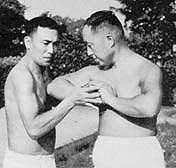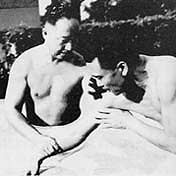Yang Family Taiji Quan - The Hidden Tradition
By Scott Rodell
Yang Lu Chan is undoubtedly the most well known Chinese martial artist
in the world. The story of his obtaining the secret art of taijiquan
in the remote village of Chen Jia Gou and his fame as "Yang the
Unbeatable" (Yang Wudi) are common stories amongst taiji players
the world over. Yang Lu Chan's reknown comes as little surprise when
we consider that the art he created - Yang Style Taiji Quan - is the
most popular form in the world today and is practiced all around the
globe. What is more surprising is that he made a little known Chinese
family art into a common exercise practice in America in less than one
hundred years.
 |
Master Wang executes ji (press)
circa
1965 |
The familiar story of Yang Lu Chan being challenged by the Emperor's
Head Guard presented him with the opportunity for lasting fame overnight.
It also offered ruin as quickly if he lost. Yet to prevail would not
mean peace, for the Imperial Guard would have lost face and could never
have let the Yang family rest. The Master reasoned the only way out,
preserving his reputation as "Unbeatable" yet avoiding retribution,
was to fight to a stalemate. To do this Yang felt a fighter's skill must
be three time greater than his opponents. History records that the bout
did indeed end with a draw.
That major obstacle over come, another fell in Yang Lu Chan's path.
The Imperial family decided Yang would teach them his art. Today it is
difficult to see how this created a problem for the Master. But China's
rulers at the time were Manchu's from the North. The Chinese thought
of them as invaders and outsiders. Patriotism in mind, Yang did not want
to give his art to outsiders. Yet an Emperor's wish is dangerous to deny.
So Yang Lu Chan created a New Yang Style, similar in posture to the Chen
family's style, but leaving out many parts of his personal style. This
was the beginning of what we now know as the Yang Jia (Yang Family) Mi
Chuan (Hidden Tradition) or Lao (Old) and Xin (New) Yang styles. One
style kept within the family and the other open to the public.
Later when Yang Lu Chan's sons , Chien-ho and Ban-ho, and Grandson,
Chen-fu began to teach all Chinese they secretly continued this two form
tradition out of necessity. For if the aristocracy learned of Yang Lu
Chan's earlier deception, trouble would soon arrive. Many martial artists
(particularly non-Yang stylist) claim that the New Yang Style is useless
martially, and that Yang Lu Chan purposely made it so. This claim is
completely without basis as even a quick review of Chinese martial history
and contemporary masters shows. Yang Lu Chan's grandson, Yang Chen-fu
never studied the older Mi Chuan form, yet was well known as a boxer.
Many of Chen-fu's students, notably Chen Wei-ming and Cheng Man-Ch'ing,
are taiji legends today. And America's most well known exponent of taijiquan's
martial component, William CC Chen, studied the New Yang Style form exclusively.
 |
Master Wang executes zou (elbow) |
Yet what then remains of the Yang tradition and what does the Mi Chuan
form hold that the New form lacks? Amazingly the Mi Chuan part of
the Yang style was within one teacher of extinction. The story of
its preservation
is typical of the twists and turns of Chinese martial history.
Yang Lu Chan had long been dead when his son Chien-ho decided to pass
the secret art outside the family for the first time. In that era reputations
were made through challenges not workshops. Yang Chien-ho once had a
bout with a master from the Zi Ran Men (Natural Style School), Du Xing-wu,
which had been a draw and remained unsettled. A student of Du's decided
to re-challenge the Yang family for his teacher. This student's name,
Wan Xing-wu, was fast becoming known in China as he traveled making and
winning challenges.
When Wan arrived at the Yang family training center, the students inside
were all concerned that they would be called upon to go out and face
this challenger. As they stood in the court yard looking at each other
one spoke up, Zhang Qin-lin. "Okay, I'll go see what Wan wants," said
Zhang and he went out the gate.
|
Caption: Master Wang executes ban (twist) |
To everyone's amazement he returned in a few minutes unhurt and Wan
was gone. Zhang told them Wan had "asked for a lesson so he could learn
of the Yang style" (the polite way of issuing a challenge). To which
Zhang agreed. Knowing that the Zi Ran Men fighters were particularly
good with their feet, Zhang was on his guard when Du began with a right
kick. Zhang swept it to the side and threw his punch into the opening.
Wan at the same time also threw a strike and their hands collided. Wan
immediately stopped and bowing shouted "Gao Ming (great)!" Zhang
assumed Du's wrist had been so hurt that he could not continue. Zhang at that time had been studying the New Yang Style with Yang Chen-fu.
Chien-ho, having seen Zhang's loyalty and love of his teacher called
him into his personal quarters to look him over. Chien-ho noticed that
Zhang truly had the body of a martial artist. He was short and heavy
with hands and feet that were twice as big as normal. He had ventured
to the Yang family's home at the age of fourteen after his parents death
to pursue his love of martial art. Chien-ho seeing this decided to secretly
teach Zhang the Mi Chuan form never before seen outside the Yang family.
 |
Master Wang practices dalu with student |
Zhang Qin-lin was later to become famous by winning the All China Fighting
Championships in 1929 in the unarmed division. T.T. Liang (Cheng Man-ch'ing's
senior student) described Zhang as having amazing abilities. During the
Second World War, Cheng ran into Zhang in Nanjing. They had both studied
under Yang Chen-fu and the younger Cheng must have wanted to test himself
and challenged Zhang to push hands. Liang described the encounter with
a wave of his hand, "Zhang just pushed him down." The story
goes that Cheng bowed to Zhang and studied push hands with him for nine
months. In the end, Cheng challenged Zhang to a fight and was knocked
out.
What made Zhang so strong? Liang said "He learned something in
the mountains from a Taoist." It was Zhang's Taoist lifestyle which
lead him to choose a quiet life instead of one teaching martial arts.
In all Zhang only taught seven students (Cheng Man-ch'ing, Wang Shan-zhi
and Li Yun-long of Hebei, Hu Yao-zhen, Liu Zhi-liang, Su Qi-geng and
Wang Yen-nien of Shanxi) . Of these seven only one remains alive; Wang
Yen-nien living in Taiwan teaches the Mi Chuan Taijiquan.
Wang was able to study with Zhang only after he received an introduction
from his father who was studying Taoist Mediation at the same Dao Guan
(Taoist study center) as Zhang. Today at 86 Wang is the last and youngest
of Zhang's students. No one knows what ultimately became of Zhang Qin
lin.
Du Xing-wu later became Sun Yet-sen's personal body guard.
Acknowledgement:
This article was originally published in Inside Kung-Fu
magazine and republished in the Ultimate Guide to T'ai Chi, 2000. Reproduced
with permission of Scott Rodell
About The Teacher:
Scott Rodell is the Founder and Director of the Great River
Taoist Center (headquartered in Washington, D.C.), and has branches in
Baltimore and across Russia, Estonia and Finland. He began studying martial
arts at nine years of age. Experience included Karate, Judo, Tournament & Instinct
Archery, Wrestling, Olympic Fencing & Marksmanship before devoting
his training full time to taijiquan. In taijiquan he has over 20 years
training in two branches of Yang Taijiquan. He studied with several senior
students of Zheng Manqing, including noted masters William C.C. Chen & T.T.
Liang. He also studied push hands & free fighting with Chen & push
hands & sword with Liang. Rodell is also a disciple student of Master
Wang Yen-nian of Shanxi province with whom he studied all aspect of Yang
family Michuan (Secret Teaching) Taijiquan. During the late '80s was
Push Hands Champion at several Nationally Sanctioned tournaments & placed
Second in Push Hands at the International Championship held in the Republic
of China in 1991. Rodell has been teaching regular seminars from beginners
taijiquan to advanced Chinese Swordsmanship in Europe since '91. He was
awarded “Honored Judge” rank by the Russia Wushu Federation
(their highest rank), and is author of "Taiji Notebook for Martial
Artists and "Chinese Swordsmanship, The Yang Family Taiji Jian Tradition".
Rodell was also one of the first ten Americans to enter the door of the
Jin Shan Pai, a traditional school of Daoist Neigong (qigong). Rodell,
initiated into the Jin Shan Pai by Wang Yen-nian, is a sixth generation
teacher in this tradition. Through the Center, local students in the
Jin Shan Pai are working to create a Retreat Center for the development
of Taoist practice. He is also proprietor of Seven Stars Trading Co.
specializing in Imperial Chinese Arms & Armor.
|